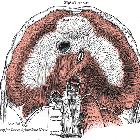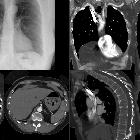diaphragmatic hernia

Ausgedehnter
kongenitaler Zwerchfelldefekt links. Magenluft und Spitze der Magensonde im Sinne einer Hernie oberhalb des Zwerchfellniveaus. Herz und Thymus nach rechts verlagert (Mediastinalshift). Trachealtubus nach rechts abweichend.

Thoraxmagen
mit erheblicher Luftfüllung. Nebenbefundlich erhebliche Höhenminderung mittlerer BWK mit Hyperkyphose.


Diaphragmatic
hernia • Diaphragmatic hernia - Ganzer Fall bei Radiopaedia

Diaphragmatic
hernia • Diaphragmatic hernia - Ganzer Fall bei Radiopaedia

Diaphragmatic
hernia • Diaphragmatic hernia - adult - Ganzer Fall bei Radiopaedia

Diaphragmatic
hernia • Massive intrathoracic stomach from chronic diaphragmatic rupture - Ganzer Fall bei Radiopaedia

Diaphragmatic
hernia • Large anterior diaphragmatic hernia - Ganzer Fall bei Radiopaedia

Diaphragmatic
hernia • Diaphragmatic hernia - Ganzer Fall bei Radiopaedia

Diaphragmatic
hernia • Diaphragmatic hernia simulating pleural effusion - Ganzer Fall bei Radiopaedia

Diaphragmatic
hernia • Hiatus hernia simulating lung sequestration - Ganzer Fall bei Radiopaedia

Diaphragmatic
hernia • Incarcerated diaphragmatic hernia with large bowel obstruction - Ganzer Fall bei Radiopaedia

Diaphragmatic
hernia • Diaphragmatic hernia, chronic gastric volvulus and aortic arch aneurysm - Ganzer Fall bei Radiopaedia

Diaphragmatic
hernia • Congenital diaphragmatic hernia - Ganzer Fall bei Radiopaedia

Diaphragmatic
hernia • Morgagni hernia - Ganzer Fall bei Radiopaedia

Diaphragmatic
hernia • Iniencephaly with diaphragmatic hernia - Ganzer Fall bei Radiopaedia

Diaphragmatic
hernia • Congenital diaphragmatic hernia - Ganzer Fall bei Radiopaedia

Diaphragmatic
hernia • Large diaphragmatic hernia - Ganzer Fall bei Radiopaedia

Foramen of
Morgagni • Diaphragm (under-surface) - Ganzer Fall bei Radiopaedia

Sagittal CT
of the chest with intravenous contrast demonstrates a Morgagni hernia (red arrow) containing abdominal fat.


X-rays image:
Double Contrast Barium Enema depicting gas filled loop of colon trapped outside the normal peritoneal confines. This marks the entrance or exit of transdiafragmatic, colonic herniation.

Diaphragmatic
hernia • Large diaphragmatic hernia - Ganzer Fall bei Radiopaedia
Diaphragmatic hernias (alternative plural: herniae) are defined as either congenital or acquired defects in the diaphragm.
Demographics and etiology
Congenital
There are two main types of congenital diaphragmatic hernia (CDH)s which are uncommon yet distinct entities that usually occur on the left side (80%) of the diaphragm :
- Bochdalek hernia: most common (95%), located posterolaterally and usually present in infancy
- Morgagni hernia: smaller, anterior and presents later in life, through the sternocostal angles
Acquired
There are a variety of etiologies for acquired diaphragmatic hernias that usually occur in adulthood :
- traumatic diaphragmatic rupture through either penetrating injury (65%) or blunt trauma (35%)
- hiatus hernia
- iatrogenic
Depending on the location and size of the defect retroperitoneal or intra-abdominal organs and tissues can prolapse into thoracic cavity due to the negative intra-thoracic pressure .
See also
Siehe auch:
- upside-down-Magen
- Hiatushernie
- Bauchwandhernien
- Zwerchfell
- Bochdalek'sche Hernie
- Morgagni-Hernie
- Larrey Hernie
- kongenitale Zwerchfellhernie
- Zwerchfellruptur
- colonic diaphragmatic herniation
- postoperative Zwerchfellhernie
und weiter:
- Zwerchfellhochstand
- Zwerchfellbuckel
- Ehlers-Danlos syndrome
- obstetric curriculum
- lemon sign
- Morgagni-Larrey hernia
- organo-axial gastric volvulus
- komplette Verschattung Hemithorax
- Magenvolvulus
- mesenteroaxialer Magenvolvulus
- fetthaltige mediastinale Raumforderungen
- collaborative publications by radiopaedians
- Zwerchfelldefekte

 Assoziationen und Differentialdiagnosen zu Zwerchfellhernie:
Assoziationen und Differentialdiagnosen zu Zwerchfellhernie:






